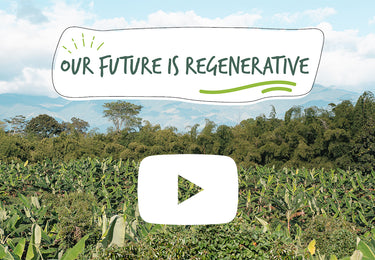If you have been following us on social media or keep up with our newsletters, you might already know a little bit about Regenerative Agriculture. We enjoy being able to share this passion that is now ingrained in who we are as a company. Our CEO, Juan Pablo Guzman, was thrilled to give us a well-rounded overview of what Regenerative Agriculture is, and what it means for us as consumers and the future of farming.
When and why it all began
Our journey with Regenerative Agriculture can be traced back to Artisan Tropic’s origin story, and our family’s collective health journey. There are two key moments that come to mind, the first being Maca’s father-in-law, Oscar. As Artisan Tropic was beginning and establishing relationships with farmers in Colombia’s coffee region, Oscar was really questioning conventional agriculture and exploring organic biodynamic farming. These practices and standards for agriculture were different from what we have known, and that sparked curiosity in us. The second moment was in early 2020 when I heard a podcast conversation with Zach Bush in which he really outlined the importance of soil health and the connection with the food we eat, the nutrition we receive, and thriving human health being connected to the health of all living things. I remember having a conversation with Maca afterwards, and our excitement was mutual. We started to ask ourselves what that could mean for Artisan Tropic’s future.
Artisan Tropic’s aim has always been to produce clean, nutritious, and delicious snacks. That goal and vision has not changed; what has changed is what we have learned along the way. We allowed our curiosity to bloom, and as we dove deeper into our connection with our farm in Colombia—the place, the people—we made room for a potential shift in our farming process. The more we learned, the surer we became that it was indeed possible to grow the food we needed in a way that would be optimal for human consumption and our planet. We never started out thinking we knew everything; it was our openness to change that led us to initiating Regenerative Agricultural practices.
Affecting change
Seeing everything in person and watching transformation take place at the farm level is beyond exciting and inspiring, but it doesn’t come without its challenges. A transformation like this one—taking a parcel of land and changing your farming practice—does not happen overnight; it’s a process that takes time, energy, and a lot of patience. There’s a benefit to not being in Colombia all the time. You really notice just how much progress has been made when you can only see it in person every few months. Every time I travel to our farm in Colombia’s coffee region, I see Regenerative Agriculture’s effects on the land, and I am always taken aback, reignited with passion and motivation to do my part— the day-to-day tasks that are required to make this business function. Another thing to add is the farmers and their major role in all of this; they have gone on this journey with us, unlearning many things that they have been doing for decades in order to implement more holistic, diverse, and beneficial practices that resemble nature’s wise design. Their willingness to learn alternative farming methods and shift their practices has been so inspiring. They also want what we want: better soil, better water, cleaner food, better working conditions, and an overall healthier ecosystem. They were and continue to be excited by Regenerative Agriculture.
Restoring balance
These days, it can be very easy to view something mechanically—the belief that each part in one whole is isolated, therefore every element can be viewed independently in the large scheme of things. This is the opposite of what Regenerative Agriculture teaches. What farming and nature reveals so clearly to me is that there is an incredible interdependence between all life—there is no isolation or separation. Everything exists in a living system, and living systems cannot be reduced to singular things that need to be fixed by being removed or treated independently. They can only be addressed if you look at it at as whole. That is the foundation of practicing Regenerative Agriculture: trying to emulate and replicate what nature does so perfectly—a synergistic relationship where all life thrives. There is a clear cycle of life and death in nature. It’s circular and there is no evil in it, it’s just the way things regenerate and evolve. There is death and decay, and then comes rebirth and transformation. These are all important and necessary parts of how nature operates, and it couldn’t be more evident at a farm, but it has also been so eye-opening to apply this knowledge to how I view life in general. These cycles are present at a human level; we operate in a cyclical life system. We have and always will be a part of nature—there’s no escaping that fundamental truth.
Devotion requires patience
This takes time. Switching and committing to Regenerative Agricultural practices is not a quick fix, it’s an investment. It’s also not a quick financial turnaround. There are costs of doing the work necessary to implement these practices because it’s a very labor-intensive job that requires time and energy from our farmers.
We are at such an early stage when it comes to the consumer understanding Regenerative Agriculture, which brings on some challenging conversations for us as a team. How should we communicate this message and the importance of it all? How do we inspire others in hopes that this mission’s value is recognized?
These are just some of the daily challenges that directly affect us as a company, but our passion and conviction drive our devotion to our overall mission.
Celebrating the miracle of food
I believe the Regenerative Agriculture movement brings on an incredible opportunity: to raise our consciousness around our connection and relationship with food. There has been a complete loss in connection to our food in today’s modern food system. When we have a meal, we usually don’t know where that food was grown, we don’t think about the people who work day and night produce it, or the trucks that transport our food to the grocery store, and the people who stock the shelves and help us check out. When we buy our food and put it on a plate, we don’t think about all the lives involved, let alone the sheer miracle that is food growing on trees or in the ground. If at any point these systems in nature don’t collaborate, we don’t get to go grocery shopping and serve ourselves and loved ones a meal. Regenerative Agriculture can connect people to the miracle that is life, food, and nutrition, reminding us that anytime we nourish our bodies, it’s a sacred celebration of life!





